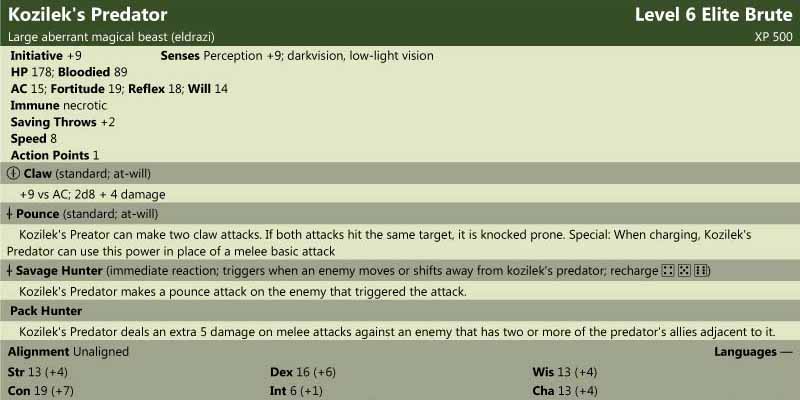Rising Stars, Part II
May 3rd, 2010
Hello everyone. Last week I discussed some design elements of the latest Magic: the Gathering expansion set, Rise of the Eldrazi, and examined some of the lessons we can take from those elements when designing for other things—with special focus on applying them to D&D. Today I’m going to finish that discussion by talking about rebound, totem armor, and the Eldrazi themselves. Speaking of the Eldrazi, at the end of the article you’ll find Kozilek’s Predator, the next part in my ongoing project of providing D&D stats for each and every Eldrazi.
Rebound is a new mechanic introduced in this set which allows a spell to be cast again (for free, no less) on your first turn after you cast it. It doesn’t seem to really have a whole lot to do with the rest of the set, and is clearly one of those mechanics that could theoretically go into any Magic set, but there are a few reasons why it shines especially bright in Rise. Primarily, it’s because it tends to make for more expensive spells, and for spells with larger effects, which meshes well with the so-called “battlecruiser” Magic design that the set’s designers were trying to create (a Magic environment which strongly encouraged huge creatures which would normally be too slow to be effectively playable).
What does rebound mean for D&D? Well, the flavor of the idea is certainly cool, and there’s a metamagic feat (in Complete Arcane, I believe) which does precisely the same thing. From a design standpoint, however, that’s more of a surface similarity than anything else. There are basically two kinds of rebound spells in the set. The first is spells such as Staggershock, which are mana efficient (4 damage for 3 mana) but limited by rebound in that they can only deal 2 of that damage at a time, effectively preventing the spell from killing creatures with more than 2 toughness. If used correctly, Staggershock can be a powerful spell. Used inexpertly, it’s merely mediocre. The other kind of rebound spell is exemplified in Nomads’ Assembly, which provides you with a lot of creatures now, and even more next turn—IF you can keep them all alive that long, something your opponents will no doubt stop at nothing to prevent.
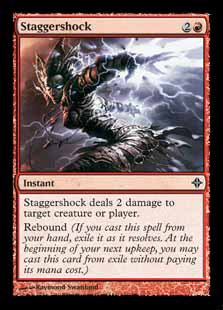
Rebound, then, is a bit of a challenge mechanic. Moreso even than most other mechanics, it rewards you for using it properly, and though it doesn’t necessarily punish you for using it clumsily, the extra mana in its casting cost is rarely justified unless you really know how to use the spell properly. Generally speaking, D&D doesn’t have much in the way of “challenge” abilities, because they are rarely very balance-friendly: they tend to either be too weak or too powerful, depending on the skill of the player using them. There are a few spells which are hidden gems, but whether that was even the intention of their respective designers is not something I can really guess at. While including some game elements which reward clever thinking and understanding of the game system is good, it’s very important not to go overboard. To be honest, I think this is one realm of game design where Magic is just different from D&D (there are many, but not as many as I imagine most players would guess).
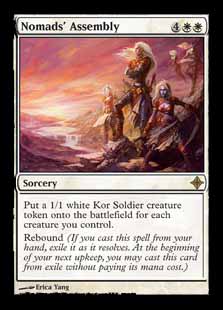
Next up is totem armor, a new mechanic which attempts to overcome the two-for-one weakness inherent in “aura” enchantments. For those who don’t play Magic, or who only play casually and haven’t had the misfortune of being told that auras are terrible… auras are terrible. Because they are dependant on the permanent they enchant, they invite your opponent to get a two-for-one by destroying that permanent, thereby killing off two of your cards for the low, low price of one of theirs. And since more cards generally equals more power…
Wizards designers have fought long and hard to make auras playable. They made licids, creatures which could turn into enchantments and then turn back, saving themselves from oblivion. They printed some which return to your hand when they go to the graveyard. They made equipment, which is essentially an artifact version of an aura that isn’t destroyed when the creature it’s attached to goes away. These are just a handful of examples. Totem armor is the latest in this long and proud tradition, and what it does is provide your beloved creatures with an extra layer of protection, because if anything would kill your little minion, you can save it by sacrificing the armor, instead. This won’t protect against everything (0 toughness, exile, being bounced, etc) but it does go a long way towards making auras more viable.
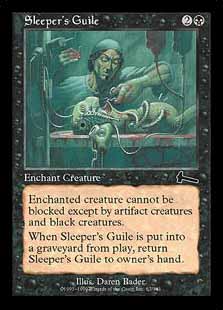
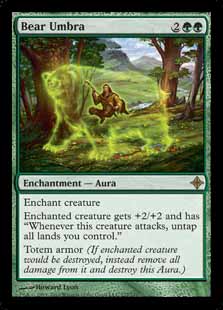
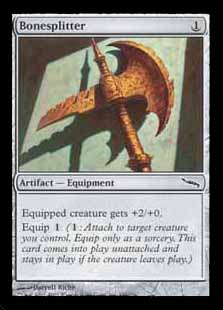
Each of these cards attempts to solve auras' inherent weakness.
And what does this one have to do with D&D? Only a little, to be honest. Totem armor is all about protecting your creatures from harm. In D&D, you rarely have creatures you need to protect, but instead have invested quite a bit into your gear. The aspects of the game which can strip you of your stuff are few, but they are feared. Rust monsters, mage’s disjunction, and sunder are the bane of adventurers who like their shinies. Depending on your DM and your play style, these things might be something that happens only infrequently, or they may be a real problem. Anti-rust protection has been around since at least the Magic Item Compendium, possibly longer, but as far as I know there’s nothing to protect your things from disjunctions (with the possible but unlikely exception of our own bad luck stone, found in Into the Armory), and only a very obscure special material to protect against sunder (though I guess blacksteel, also in Into the Armory, would do that too). Still, I’d like to see a little more “stuff insurance” available in D&D, because losing gear is devastating in much the same way that losing an enchanted creature is devastating, except that it’s generally harder to avoid. Luckily for me, I’m a game designer, so, I can probably do something about that. Don’t be surprised to see something in an upcoming From the Workshop.
And finally, there are the Eldrazi themselves. Gigantic, Lovecraftian monstrosities from another world, the Eldrazi are just plain cool. And big. Really, really big. In any other set they would be completely unplayable. But with all of the mana acceleration in Rise, as well as the focus on slowing down gameplay, it is doable. And it’s really, really fun. The lesson? Big, awesome stuff is, well, awesome. Players like to get a lot of bang, and often are happy to do so regardless of how much buck they have to shell out for it (I think I just butchered that expression). Personally, I feel that D&D suffers from a bit of a shortage in the realm of really big, really cool effects, especially for players, as opposed to DMs. These effects are hard to balance, of course, but I think that the fun factor is well worth the cost, and it’s a major design goal here at NNW to make sure that we put out a certain amount of “Timmy” love, to borrow from the Magic psychographs (for those not familiar, “Timmy” is a fictional player who represents those magic players who really enjoy, well, big, splashy, fun effects).
And speaking of Eldrazi, here’s Kozilek’s predator:
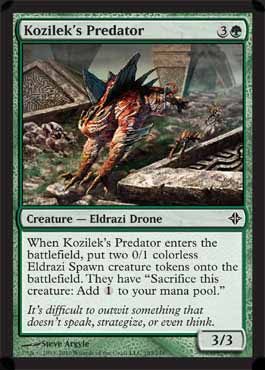
Kozilek’s Predator (CR 5)
XP 1,600
N Large Aberration (eldrazi, extraplanar)
Init +6; Senses darkvision, low-light vision, scent; Perception +11
DEFENSE
AC 16, touch 12, flat-footed 13 (+3 Dex, +4 natural, –1 size)
hp 60 (8d8+24)
Fort +5, Ref +5, Will +7
Immune: Negative energy
OFFENSE
Speed 40 ft.
Melee bite +12 (1d8+7), 2 claws +13 (1d6+7)
Space 10 ft.; Reach 5 ft.
Special Attacks pounce, rake (2 claws +13, 1d6+7)
STATISTICS
Str 25, Dex 17, Con 17, Int 2, Wis 12, Cha 7
Base Atk +6; CMB +14 (+18 grapple); CMD 26 (30 vs. trip)
Feats Improved Initiative, Run, Skill Focus (Perception), Weapon Focus (claw)
Skills Acrobatics +11, Perception +11, Stealth +3
ECOLOGY
Environment any
Organization solitary, pair, or pride (3–8 plus 3d6+6 Eldrazi Spawn)
Treasure incidental
And, for 4e:
